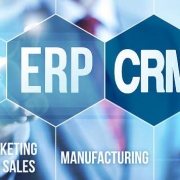ERP Vs. CRM: What’s The Difference?
Two of the most important tools you can have in place for your business are enterprise resource planning (ERP) and customer relationship management (CRM) systems. Sometimes ERP and CRM become synonymous or are referred to as a bundled singular system While they are separate business processes, it is a great advantage to have both systems in place, and working together. Alana Rudder and Rob Watts share an informative article on Forbes comparing both these business processes, and how you can utilize them both for your business.
At its core, Rudder and Watts explain, an ERP system serves as a central database to integrate and facilitate automations and efficient resource allocation—including funding—between company functions. In contrast, a CRM gives companies the tools and capabilities to build and maintain positive relationships with key stakeholders. ERP help companies manage their finances and resources to control costs and meet company production goals. CRMs help companies manage the sales cycle and customer experience. Both ERP and CRM systems offer cloud-based databases to ensure users can access accurate, real-time data from anywhere and from any device. They both collect data, but for different reasons – ERP collects data from systems across the business to create one source of data truth, while CRM collects data on leads, prospects and customers to create a complete view of their preferences, needs and interaction and purchase history. Additionally, the article points out that while ERP systems allow for integrations to manage sales cycles, marketing, customer service and the compilation of complete customer views, these processes are better handled by CRMs. However, when it comes to managing manufacturing processes, resource planning and allocation, financial management, supply chains and production, an ERP is a better solution. A real competitive edge can be accomplished by integrating the two solutions.
Sales Management. “Both ERP and CRM solutions have unique features that can lend to more closed sales. A CRM offers tools to help sales representatives determine if prospects or leads are likely to buy, reach out to “hot” leads, personalize interactions to uniquely meet the needs of existing and potential customers and, ultimately, close sales. An ERP can lend to smooth sales closing processes by ensuring products are produced and available to meet demand. In doing so, it ensures sales representatives have products available to sell when customers want them. Such capabilities include demand forecasting, resource planning and procurement and automations to speed up production.”
Supply Chain Management. “An ERP system is the stronger solution for supply chain management. Many offer tools to manage the entire production process, from resource procurement and planning and supply chain management to the manufacturing process. However, a CRM offers the tools to make supply chain management worth the investment, including via marketing, sales and customer service management. Together, ERP and CRM solutions offer companies the whole spectrum, from investment in and the use of raw materials to the sale of final product outputs.”
Customer Experience. “Creating a positive customer experience is better left to a CRM solution. Companies can lean on the solution to make personalized sales that induce fewer complaints, then offer follow-up support, quick customer complaint resolutions and personalized upsells that further prompt a positive customer experience. However, the customer experience is often poor if supply chain and manufacturing processes are not on point. An ERP system helps companies manufacture products while correctly balancing quality and cost. This, combined with its demand forecasting, allows sales representatives to offer the products customers want, when they want them and at the right price, thereby inducing fewer complaints and higher customer satisfaction.”
Deciding whether or not your business needs an ERP or CRM system, or bother comes down to the primary needs and goals of your company. While having one over the other has its own advantages, you may find that you will need both systems and will need them to work together to gain a competitive advantage.



